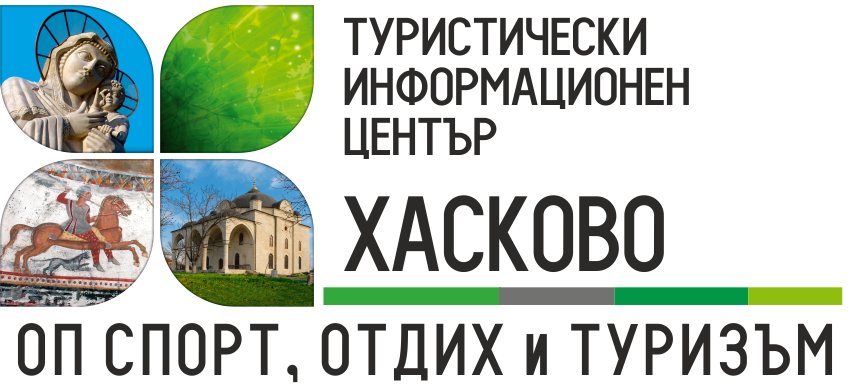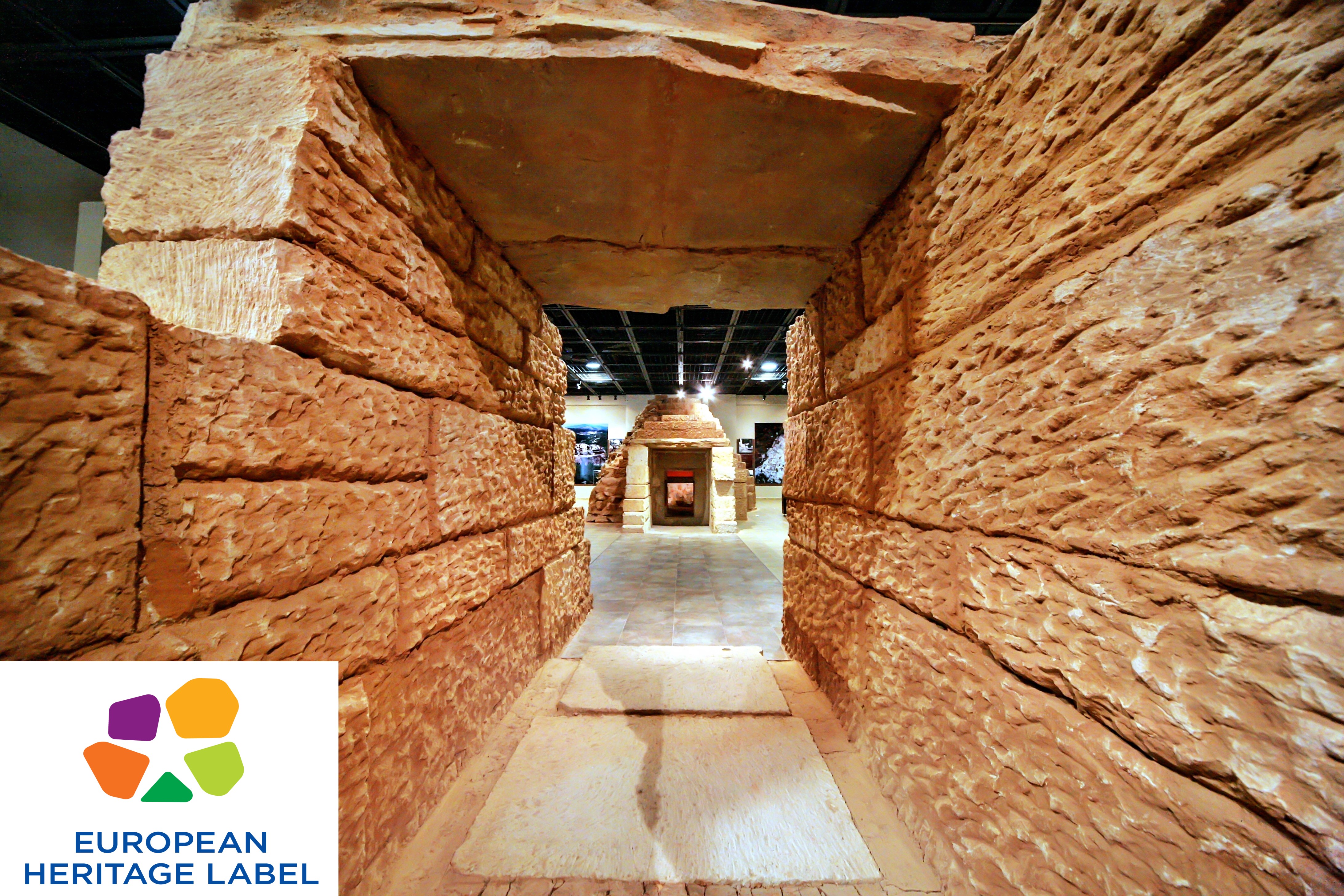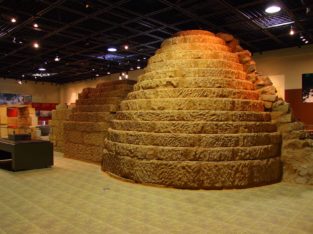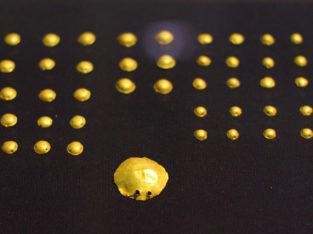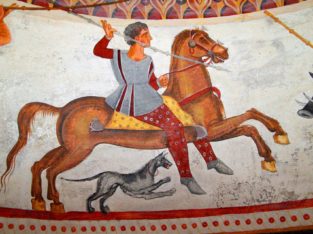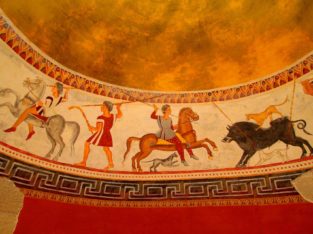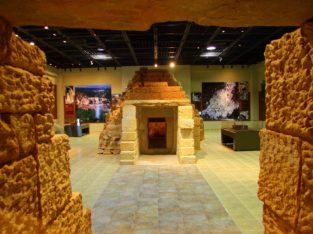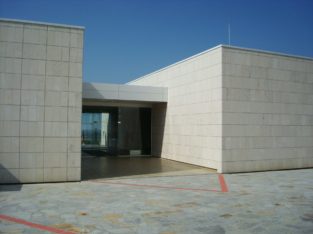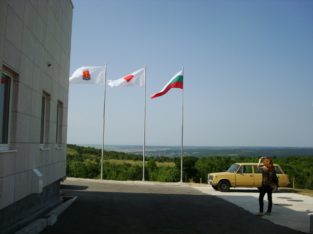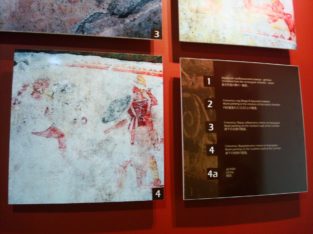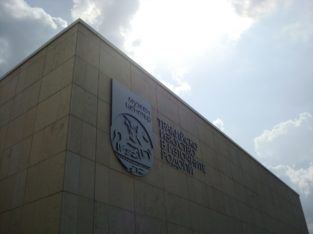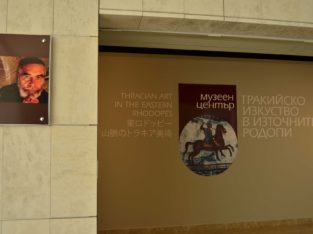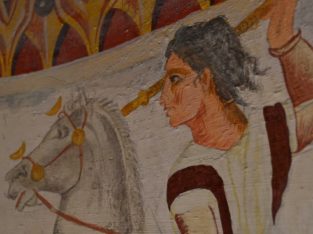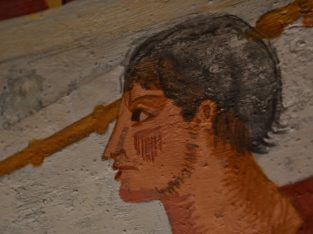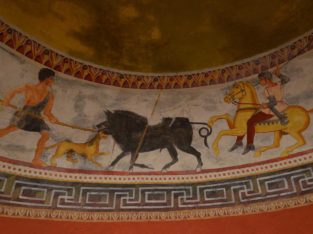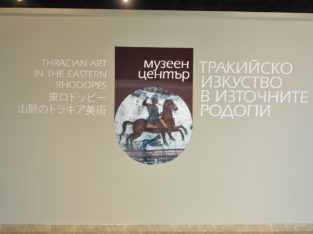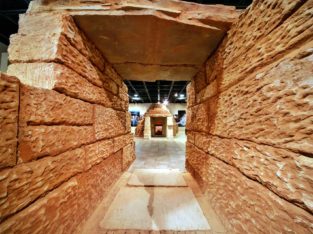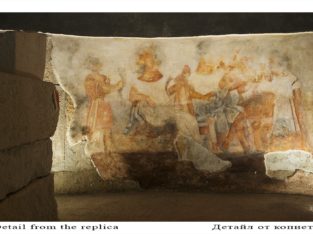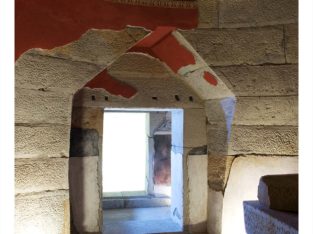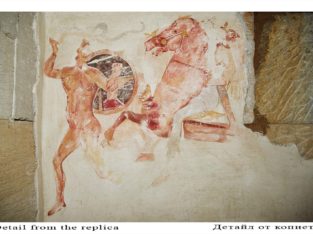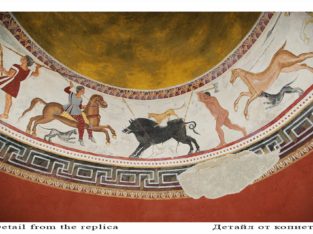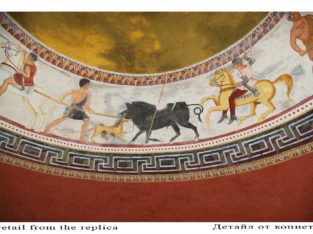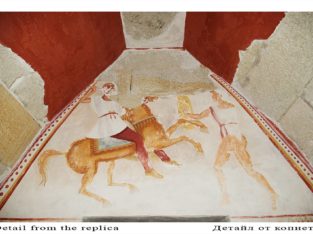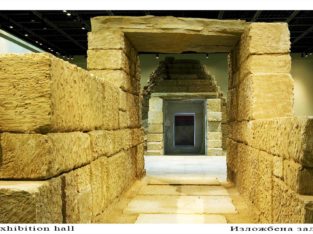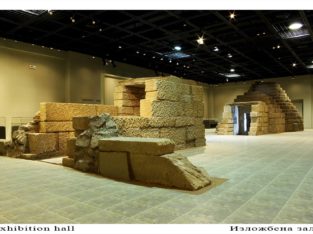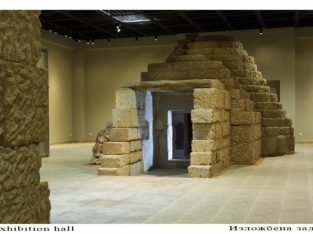Alexandrovo Tomb
There are preserved traces of many prehistoric, Thracian, Thracian-Roman, Late Antique and Medieval settlements in the surroundings and the confines of Haskovo. In December 2000, a team of archaeologists led by Dr. Georgi Kitov (1943-2008) discovered a unique Thracian tomb from the IV th century B.C. in the mound Roshavata Chuka near the village of Alexandrovo..
The building played the role of a last shelter for some Thracian ruler whose name remains a mystery to us. With its frescoes and architecture, the tomb is one of the pearls of Thracian cultural heritage in our lands and ranks among the largest facilities of its kind found so far. The tomb’s unique frescoes are unparalleled and they enrich with new data our ideas about the Thracian religious rituals, cults, weapons, life and clothing.
Alexandrovo’s tomb is the only site in Bulgaria to bear the European Heritage Label (2021).
Hunting, battle storylines, as well as scenes of funeral feast, alternate with monochrome zones and zones with ornamental decorations. In the notions of the ancient Thracians the order in the Universe could be established by a victory over the forces of chaos. By defeating the boar –incarnation of the chaos, the ruler could restore the world order and acquire a new, higher status.
Museum Center “Thracian Art in the Eastern Rhodopes”
In 2009 the Museum Center “Thracian Art in the Eastern Rhodopes” was opened, established under the Program of the Japanese Government for Cultural Grants. The museum is situated in the immediate vicinity of the mound with the original tomb. One part of the building is designed as a rich museum exposition and a copy of the tomb in a scale of 1:1, while the other part is a modern scientific research center with laboratories furnished with modern equipment for restoration and conservation.
The permanent exhibition in the museum provides information about the tomb in the context of the Thracian culture from the period of its flourishing V-ІІnd century B.C. The rich exposition shows many artefacts from the Thracian period in the region of Haskovo and many of them can be seen in the frescoes of the Alexandrovo Tomb – armament, jewels, and vessels. Among the brightest exhibits in the exhibition are the 98 golden applications (4500 – 4000 B.C.) found in the northern part of the Sakar Mountain. Together with the golden jewels from the Varna necropolis and the necklace from the village of Hotnitsa, they are the oldest processed gold in the world.
The roundabouts and the present urban area of Haskovo have preserved many traces of prehistoric, Thracian, Thracian-Roman, Byzantine and medieval villages. In December 2000, a team of archaeologists under the guidance of Dr. Georgi Kitov (1943-2008), made one of the most significant discoveries in Bulgarian archaeology at the mound “Roshavata Chuka” near the village of Aleksandrovo.
Penetrating deep through a hole earlier made by treasure hunters, archaeologists came across a Thracian tomb dated the IV century B.C. with frescoes incredibly well-preserved. The very first view revealed unique artistic decoration, unparalleled to other facilities of the kind. The architecture of the tomb is also impressive, rivalling in size the best examples of historic monuments across our land. The mound is located near the village and stands out against the background of the area as a beautiful hill. The height of the mound is about 15 meters and its diameter exceeds 70 meters. A 14-meter corridor has its beginning on its eastern periphery, passing alternately through a rectangular and a circular room.
The edifice was used as a heroon (temple-mausoleum). The small height of the corridor and the two entrances make visitors bow to be able to pass underneath, entering a world of rich colours and patterns, floral and geometrical motifs, images of footmen and horsemen, domestic and wild animals. The frescoes are made in an unexpectedly realistic way, standing out with exclusive scientific, artistic and original value and leaving an unmatchable impact.
Bulgaria is one of the oldest countries in Europe. Throughout its multi-centennial history it has gone through periods of ups and downs, of many testing periods. Geographically located on key crossroads connecting the East and West, Europe and Asia, the area of Haskovo reflects the entire history of Bulgaria. The oldest settlements excavated in the city date back to the Neolithic era (V millennium B.C.). Evidence of its long history are the numerous prehistoric, Thracian, Roman, late antique and medieval monuments found within its area.
The Regional Museum of History in Haskovo keeps over 120 million monuments of cultural heritage, many of which outstand with singularly value. Unique collections of prehistoric, ancient and medieval artefacts from ceramic, stone, iron and glass add to the rich collection of the Museum. Some of the most interesting exhibits are two rarely found cups in Bulgaria, both of the so-called “Trojan type” dating from the 1st century B.C., one of which is a symbol of the museum. The exhibition includes also extremely valuable collection of ancient and medieval coins, totalling more than 22,000 pieces. Over the years Haskovo’s Regional Museum of History has been engaged in collection, research and methodological activities in all 11 municipalities through the district of Haskovo.
The permanent exhibition in the Museum Center “Thracian Art in the Eastern Rhodopes” provides information about the tomb in the context of the Thracian culture in its peak, namely V-II centuries B.C. Visitors can trace the chronology of discoveries and studies and know more about the interpretation of the murals.
On a regional level, the Thracian cultural heritage is represented through movable monuments of culture dating from Late Iron Age (VI-I centuries B.C.). The museum is the place to see the most remarkable archaeological monuments discovered in different parts of the Eastern Rhodopes, Sakar Mountain and the valley of the Maritsa River.
Besides the replica of the Tomb of Alexandrovo and its unique murals, which has applied for a UNESCO monument, the Museum Center “Thracian Art in the Eastern Rhodopes” displays for the first time a gold treasure dated around 4500-4000 B.C. Jewellery similar to artefacts discovered in the Varna necropolis, are the oldest gold treasure discovered in the world.
Authors of exhibition:
Thematic plan – Irko Petrov
Spatial layout – Professor Bozhidar Ionov
Photos – Ivo Hadjimishev, Assistant Professor DSc Nikolay Ovcharov, Dr. Georgi Nehrizov, Irko Petrov
Maps – Professor Dr. Valeria Fol, Stanislav Iliev
Consultant – Professor Dr. Ivan Marazov
Tomb of Alexandrovo has a 15-meter long corridor. The entrance, whose facade was destroyed in antiquity, faces to the east. The corridor leads into a rectangular chamber. The roof structure is trapezoid shaped. The passage between the corridor and the vestibule is rectangular. The entrance leads to a round chamber, with a diameter of 3.30 m at the bottom and 3.40 m height.
In addition to their grace and realism, the six zones of rich murals decorating the tomb’s circular chamber refer to the fact that one of them has revealed one of the most intriguing and mysterious discovery in the tomb. It is about the richly decorated monochrome red zone, where there is a sharply incised image of a young man, in left profile. Above the portrait, there is a Greek inscription reading “Kodzimases Hrestos.” According to the interpretation, the first word is a personal name of Thracian origin, while the second one is a nickname, which means capable, skilled or dextrous. Thus, the inscription can be interpreted as Kodzimases the Master, and the graphite image may be a portrait and autograph of the artist, who painted the tomb. The red zone is crowned by a geometric frieze of linked swastikas painted in white and black. Underneath it is bordered by Ionian cyma, and above – by a narrow white box dotted in red.
Immediately above follows the best preserved figured frieze, which depicts royal hunting scenes. Hunting is one of the most popular topics in Thracian art. It can be seen on dozens of monuments, ornaments, vessels, votive tablets, etc. In the cosmology of the ancient Thracians, the cosmologic order can be established through the victory over the chaos forces. Beating the boar – embodiment of chaos, the ruler restored the universal order and moved up to a new, higher status.
The Museum Center “Thracian Art in the Eastern Rhodopes” near the village of Alexandrovo was built under the Cultural Grant Aid of the Japanese government’s Grant Aid programme.
The construction of the Museum Center started in February 2008 and it was officially opened on May 15, 2009 by Their Imperial Highnesses Prince and Princess Akishino (Norikom Akishinomiya Fumihito) and President of Bulgaria Georgi Parvanov.
The newly built Museum Center “Thracian Art in the Eastern Rhodopes” spreading on a total area of 834 square meters is located in proximity to the mound with the original tomb. One part of the building is designed for exhibiting the rich museum collection and a replica of the tomb. The other part is organized as an individual modern research center, with laboratories equipped with state-of-the-art equipment for restoration and conservation. The museum has a repository and an audiovisual hall for conferences, roundtables and thematic meetings regarding studies of the Thracian culture.
Tomb of Alexandrovo was discovered in December 2000 by a team of archaeologists led by Dr. Georgi Kitov (1943-2008). Nicknamed the “Bulgarian Indiana Jones”, the archaeologist has made some of the most exciting discoveries in Bulgarian archaeology, adding significant data to the scanty scientific knowledge about Thracian culture and history. He was mainly engaged with excavations and study of archaeological sites of Ancient and Thracian times. Some of his findings related to the Thracian culture are the tombs in the Frog’s Mound, near the town of Strelcha, the religious complex (heroon) near Starosel, the discovery of 673-gram golden mask of a Thracian ruler, the tomb of Seuthes III in Kosmatka Mound near Shipka and many others.
Dr. Georgi Kitov graduated in history from Sofia University “St. Kliment Ohridski “, specialized in history of art in Leningrad (nowadays Petersburg, Russia), worked as a curator at the Archaeological Museum and Institute at the Bulgarian Academy of Sciences (BAS). In 1977, he became Doctor of Historical Sciences. In 1992 he was appointed chairman of the General Meeting of the Archaeological Institute with Museum at the Bulgarian Academy of Sciences (BAS). He is founder and leader of the archaeological expedition TEMP (Thracian Expedition for Mound Research), established in 1972. He authored over 200 articles and a dozen essays on Thracian history, archaeology and religion. Some of his most popular books are: The Thracian Treasure from Valchitran, published in 1978; The Riches of Thracian Rulers, published in 1992; The Valley of Thracian Kings, published in 2002; The Tomb of Seuthes III, published in 2004; Introduction Thracian archaeology, published in 2002; Tomb of Alexandrovo, published in 2009 (second revised edition).
Dr. Georgi Kitov died suddenly on September 14, 2008 during excavations in Starosel, leaving a treasured memory for his tireless professional devotion and invaluable discoveries.
The replica of Tomb of Alexandrovo is the heart of the Museum Center “Thracian Art in the Eastern Rhodopes”. Restoration expert have reproduced the original facility to the tiniest detail. With enviable precision, in scale 1:1, elements of the tomb’s architecture and frescoes are reproduced. Only one deviation from the original was allowed – the low corridor was interrupted in the middle in order to facilitate access for visitors. They can walk around the entire tomb and learn about the construction techniques used by the Thracians. The enclosure of the facility, for the purpose of partially easing the enormous pressure of the mound construction, is partially reproduced.
Original murals are reproduced to the smallest detail and with precision. This magnificent set of paintings is a valuable source of information about the life and culture of Thracian peoples. The replica opens a really exciting opportunity for visitors to get in touch with this remarkable symbol of Thracian art, to feel the wind of a distant epoch, to assess the skills of the ancient builder.
Authors of the replica:
Team: Vladimir Tsvetkov, Professor Valentin Todorov, Grigori Grigorov and Elitsa Tsvetkova
Tomb of Alexandrovo is one of the largest facilities of the kind discovered so far. What makes it unique, however, is the mural paintings inside. Painting covers entirely the round and rectangular chambers and a small part of the corridor. Hunting and battle scenes, as well as scenes from a funeral feast alternate with monochromatic layers and those with ornamental decoration. Images in the first chamber are predominantly monochrome or ornamental. A horse-rider occupies the space above the entrance to the central room and a footman is opposing him, apparently in a fight.
Mural paintings in the round burial chamber outstand in diversity and richness. It is adorned with six horizontal zones in vertical sequence. Two of them have figural decoration. Best reserved is the belt zone displaying hunting scenes. Images of horsemen are particularly important because of their scientific value. The horsemen are dressed in tunics, some wear pants. They are armed with spears and swords. The forms of weapons add to the knowledge about Thracian weaponry and warfare.
The horse figures and extremely detailed detail harness are impressive are presented, which according to the colour feature gold, silver and bronze applications. Their positioning on, saddles and chest is essential for the interpretation of horse-riding sets already known. Labrys-shaped decorations (as a double ax) in decorate the space Over the horse heads.
In I millennium B.C. Thracians were one of the largest people in Europe. Divided into many tribes, they dwelled the eastern parts of the Balkan Peninsula as well as some areas in north-western Asia Minor. One of the most powerful tribal groups was that of Odrisses – Southeast Thrace, Bessi – in the Rhodope region, Getae – in the north-eastern regions, Triballi – in today’s north-western Bulgaria and Vitini – in Asia Minor. In the fertile plains of Thrace agriculture was developed, while people living in the mountain areas occupied with livestock breeding. Ore-mining, metalworking, pottery, leather and woodworking were well developed. War was a constant companion in their lives.
The most characteristic and best known, through archaeological artefacts manifesting the Thracian culture are burials of wealthy people, often in monumental tombs and under impressive mounds. The number of Thracian mounds in Bulgaria is between 10,000 and 60,000. One of the largest and most impressive is the mound near the village of Mezek, Svilengrad. Tombs discovered near Kazanlak, the village of Sveshtari, municipality of Isperih, and the one near the village of Alexandrovo, municipality of Haskovo, are world famous with their magnificent murals.
The Thracian treasures found today reveal the wealth of local aristocracy and are indicative of some of their religious rituals. Particularly impressive is the Panagyurishte gold treasure, consisting of nine gold vessels richly decorated with man-like compositions. The biggest treasure found so far is the one from Rogozen, consisting of 165 silver vessels, most of them richly ornamented. Smaller in size – containing just 5 artefacts, but of superb craftsmanship – is the treasure of silver vessels discovered near the village of Borovo, municipality of Rouse. Silver ornaments for horse harnesses with interesting figurative images are the characteristics of treasures excavated near Lukovit and Letnitsa.
Alexander Tomb is part of the European Heritage – read more here.
Useful information
Location
Contacts
Parking Place
Ability Access
Guide
Working hours
from June to August
from Tuesday to Sunday
9:00am – 6:00pm
from September to May
from Tuesday to Sunday
9:00am – 5:00pm
Monday – Closed
Prices per visit
Students and pensioners – BGN 2.00
All others – BGN 4 .00
Touring guide – BGN 6 .00
Children under 7 years are admitted for free.
